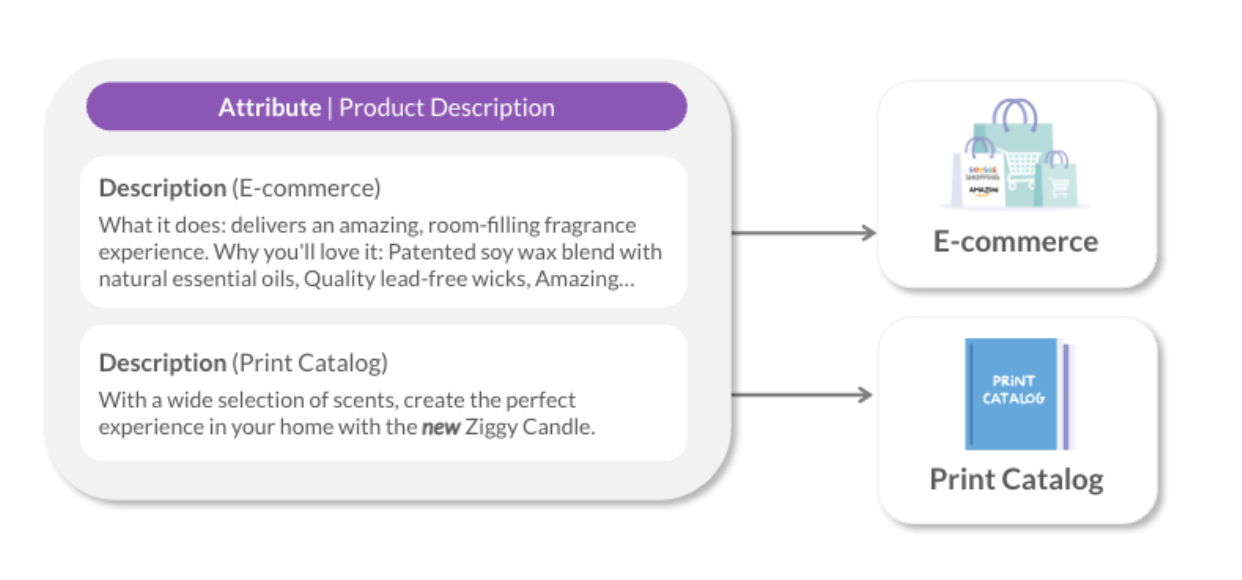From eCommerce and marketplaces to social media and print catalogs, companies must be prepared to meet customers wherever they are. Akeneo PIM can help.

Keywords
Akeneo is the ideal engine to support this omnichannel product experience strategy as it acts as a single source of truth for product information that can be quickly and efficiently contextualized and activated on every sales channel a company sells on. This benefit can be clearly quantified in Forrester’s recent Total Economic Impact (TEI) report on Akeneo, that found the incremental benefit provided by Akeneo’s data quality and management capabilities in new channels was responsible for 4.2% revenue growth over 3 years.
Are you thinking about incorporating a new sales channel into your Akeneo solution? Let’s explore what a channel is and how you can prepare your Akeneo solution to unlock growth across all customer touchpoints, whether they’re owned by you or not.
Channels in Akeneo are used to adapt product information, product assortment, and mandatory fields to meet the requirements of each customer touchpoint within a product catalog. A company with an omnichannel strategy may sell the same product across many, or even dozens, of different customer touchpoints.
A company selling in a print catalog, in an eCommerce platform, and through a marketplace may have three separate Akeneo Channels to support each version of the catalog. However, it’s important to think of each Akeneo Channel as an adaptation of product information, and not just a new destination of information.
For example, a customer with four separate eCommerce storefronts with identical product information may need just 1 Akeneo Channel. Likewise, a mobile app and an eCommerce platform could also require just one Akeneo Channel if the product information, assortment, and mandatory fields (completeness) are identical.
The first step in adding a new channel in Akeneo is to consider how your product content, assortment, and mandatory fields (completeness) will differ across channels.
Different customer touchpoints often require different versions of the same product information. When adding a channel, it’s critical to first identify which information needs to be adapted and which information can remain the same across channels.
Information that will remain the same can be left alone, while information that needs to be adapted to have a different value per channel needs to be configured in Akeneo. In the image below, you can see an example of how a Description attribute that’s been configured to have a different value per channel can support two separate descriptions.
Note: We want to avoid doing redundant work, so be deliberate in identifying which information should actually change from channel to channel and what information can be shared. Need to modify some of your existing attributes to support separate values per channel? Check out this guide.

Don’t forget about your rich content! It’s often necessary to adapt your media across sales channels too. An eCommerce platform may require multiple high resolution images, while a print catalog may have just a handful of lower resolution or even black and white images. All of these different channel specific requirements can be supported with Akeneo’s Asset Manager.
It’s common for product assortment to change across channels. Category Trees in Akeneo manage product assortment and can be used to organize products within Akeneo. Each Channel in Akeneo can have a unique Category Tree. It’s quite common for products to be organized differently across channels.
For example, print Category Trees are often much flatter while eCommerce Category Trees have multiple levels. Enriched Categories can also allow you to build channel specific category level content to build even more impactful experiences for customers.
Different channels may require more or less information. For example, a mobile or print channel may just need a few basic fields to meet customer expectations, while an eCommerce platform may need significantly more. Each channel in Akeneo can have different completeness settings to support this. This allows you to meet higher expectations for more detailed channels while launching rapidly on channels that require less information.
Bringing a new channel to Akeneo often means incorporating a new team into your Akeneo environment. It’s important to understand early on who will be enriching products in Akeneo for your new channel and ensuring you have a clear definition of their roles and responsibilities. If an existing team will be enriching the new channel, it’s still important to ensure they are aware of their new responsibilities.
New teams being brought into Akeneo must be trained to work effectively in the tool. Akeneo offers a number of training options including free online courses and paid private training. It’s also possible to have a more experienced Akeneo user enable new teammates with some hands-on training.
When adding new teammates to Akeneo, you want to ensure they’re working on the products and product information they’re supposed to with the help of Akeneo permissions. Consider which User groups and User Roles new teammates should have. Utilize Categories to control product access, Attribute Groups to control access to attributes, and Roles to control actions users can take in the PIM.
Map out the entire end-to-end product enrichment process for the new team. It’s important that every step is considered and that enrichment is done as effectively as possible. Utilize automation using Rules and Product Link Rules, and empower your teams on Teamwork assistant features to support rapid enrichment. It’s also critical to consider tasks or dependencies outside of Akeneo that new team members may need to contend with (like waiting for a photography team to take pictures, or a buyer to input a new product in an ERP system).
Now that you’ve adapted your product information for your new channel and enabled your new teammates, it’s time to get Products to your new Channel. In Akeneo, there are three primary ways to do this.
The Akeneo App Store gives you access to Akeneo Apps that provide a quick, high-quality integration to external systems with no developer intervention necessary. The App Store includes Apps for a number of platforms including Shopify, Adobe Commerce, Salesforce Commerce Cloud, BigCommerce, Channel Engine, ProductsUp, and more. In many cases, product mapping and scheduled exports can be handled directly in the Akeneo UI. Akeneo also allows you to build your own custom apps to meet your organization’s unique needs.
Akeneo Activation for Retail allows you to send high quality product information and assets from Akeneo PIM to key retailers. By leveraging easy-to-use mapping, error reporting, and support for enhanced content, you can meet the requirements of your retailers at scale and deliver the customer experiences that increase discoverability and drive conversions.
Akeneo Tailored Exports allow you to build a custom export profile to map your Akeneo product information to the format of an external destination. Ideal for getting information to business partners, retailers, or internal teams, these exports can be scheduled to deposit a file into an external location (FTP server, AWS S3 etc.) and provide you with Akeneo native integration capabilities.
It’s critical that your organization manages every sales channel with Akeneo. Managing product information outside of Akeneo leaves you susceptible to inconsistent brand messaging, data inconsistencies, siloed workstreams, and excess content enrichment costs.
Looking for other opportunities to improve your Akeneo solution? Take the Akeneo PX Strategy Assessment now.

January is the busiest season for returns, but what really drives shoppers to send products back? Our latest survey reveals the top 10 insights into...
Read more
Just like in love, customers want a shopping experience that feels smooth, reliable, and worth committing to. This Valentine’s Day, we’re...
Read more
Learn what product bundling is and explore its various types. Discover how businesses can implement this strategy effectively and leverage PIM to...
Read more